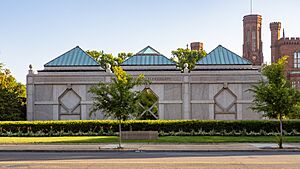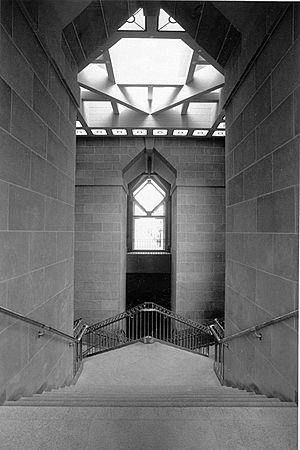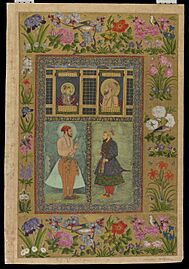Arthur M. Sackler Gallery facts for kids
 |
|
| Established | 1987 |
|---|---|
| Location | 1050 Independence Ave SW, Washington, D.C., DC 20560, U.S. |
| Public transit access | |
The Arthur M. Sackler Gallery is an art museum in Washington, D.C.. It is part of the Smithsonian Institution. This museum focuses on Asian art. The Sackler Gallery and the Freer Gallery of Art work together. They form the National Museum of Asian Art in the United States. These two galleries also have the largest library for Asian art research in the country.
The Gallery was started in 1982. It is named after Arthur M. Sackler. He gave about 1,000 art pieces and $4 million to help build the museum. The museum is located on the south side of the National Mall. It is connected to the Freer Gallery of Art. Most of the museum, about 96%, is underground. It sits below the beautiful Enid A. Haupt Garden.
Contents
How the Museum Started
In 1979, the Prime Minister of Japan, Masayoshi Ōhira, visited the Freer Gallery of Art. He announced that Japan would donate $1 million to the Smithsonian. This money was to help build an addition to the Freer Gallery. The new space would display Asian art. That same year, the United States Senate approved the Smithsonian's request. They approved $500,000 to build museums for Asian and African art.
In 1981, the plan for the new complex was approved. On December 23, Congress approved $960,000 for the project. This was special because it was the first time federal money was given without specific rules.
In 1982, Arthur M. Sackler gave about 1,000 Asian artworks to the Smithsonian. This collection was worth $50 million. Sackler also gave $4 million to build a place for these artworks. This is how the Arthur M. Sackler Gallery was founded. Construction began on June 22, 1982. More federal money, $36.5 million, was added in October. The official groundbreaking happened on June 21, 1983. Important people like Chief Justice Warren E. Burger and Vice President George H. W. Bush were there.
The gallery officially opened on September 28, 1987. Arthur Sackler passed away four months before the opening. To celebrate, Washington, D.C. Mayor Marion Barry declared the day "Smithsonian Institution Day." In 2012, the Sackler Gallery celebrated its 30th anniversary. Arthur Sackler's widow gave a gift of $5 million to mark the occasion.
Museum Design and Location
The Sackler Gallery is part of the Quadrangle Complex. This complex is located behind the Smithsonian Institution Castle. It shares the space with the National Museum of African Art and the S. Dillon Ripley Center. The complex is mostly underground, about 96% of it. It covers 115,000 square feet.
The complex was designed by Jean Paul Carlhian. His goal was to connect different underground buildings. The design uses geometric shapes. These shapes were inspired by the Smithsonian Castle and other nearby buildings. Pink and gray granite were used, matching the colors of those buildings. The Sackler Gallery is right next to the Freer Gallery of Art. It has designs inspired by Islamic art.
A 4,130-square-foot granite building serves as an entrance. This entrance is located in the Enid A. Haupt Victorian Garden. Inside, a diamond-shaped fountain is on the lowest floor. You can see it from the two upper levels. A tunnel connecting the Freer and Sackler galleries was built between 1987 and 1989. The parts of the Sackler Gallery open to the public cover 40,905 square feet.
Artworks and Collections
The Sackler Gallery has many different collections. These include Chinese, Indian, Korean, and Japanese paintings. They also have photography, modern ceramics from China, and Japanese prints from the 1800s and 1900s. Other related Asian arts are also part of the collection.
The Sackler Collection
The very first collection came from Arthur M. Sackler. He donated about 1,000 objects in 1987. This collection includes ancient and modern pieces. You can find Near Eastern metalware and ceramics. There are also sculptures from South and Southeast Asian countries. The collection also features Chinese jade and bronze pieces. Plus, there are Chinese lacquerware and paintings.
The Vever Collection
In 1986, the Sackler Gallery bought the Vever Collection. This collection has Persian and Islamic paintings and manuscripts. A jeweler named Henri Vever collected these pieces between 1900 and 1943. The Vever Collection has one of the best groups of Persian books.
Exhibitions and Displays
Exhibitions at the Gallery often focus on Asian art and culture. In 1992, two exhibitions opened. They showed art from the museum's collection and borrowed pieces. These included "Metalwork and Ceramics from Ancient Iran" and "Buddhist and Jain Sculpture from South Asia."
In 1993, "Contemporary Porcelain from Japan" showed 30 works by 30 Japanese artists. These were donated by the Japan Foundation. The first exhibition about Korean art happened in 1994. It was called "Korean Arts of the Eighteenth Century: Splendor and Simplicity."
In 1996, the Sackler hosted some of the oldest sculptures found in Western Asia. These sculptures were found in 1974 near Amman, Jordan. They were sent to Washington, D.C., for study and care. The exhibition, "Preserving Ancient Statues From Jordan," showed eight pieces. These pieces were from 6500 to 7000 B.C.
The gallery also has temporary exhibits that change. Some past examples include:
- Yoga: The Art of Transformation
- Chigusa and the Art of Tea
- Kiyochika: Master of the Night, showing Japanese artist Kobayashi Kiyochika
- An American in London: Whistler and the Thames, showing American artist James McNeill Whistler
You can find a full list of all past, current, and future exhibitions on the Freer|Sackler exhibitions page.
Caring for the Art
The Department of Conservation and Scientific Research works for both the Freer and Sackler Galleries. It was the first Smithsonian facility to use science to study art. It is still one of the few places in the United States that specializes in caring for Asian paintings.
Caring for the collections started even before the museums existed. Charles Lang Freer, who founded the Freer Gallery of Art, hired Japanese painting restorers. They cared for his artworks and prepared them for the Smithsonian. In 1932, the Freer Gallery hired a full-time Japanese restorer. This started the East Asian Painting Conservation Studio.
In 1951, the Technical Laboratory began. This was the first time scientific methods were used to study art at the Smithsonian. The East Asian Painting Conservation Studio and the Technical Laboratory joined in 1990. They formed the Department of Conservation and Scientific Research.
One project in 2009 used special laser technology. Conservators explored the "fingerprints" of ancient Chinese gold objects. This helped them learn more about the art.
Learning and Community
The Sackler Gallery offers lectures and talks to the public. It also works with the Museum Rietberg in Zürich to publish an art history journal called Artibus Asiae.
The Freer and Sackler galleries, along with a center in Japan, give out the Shimada Prize. This award is for excellent research in East Asian art history. It was started in 1992. The Sackler Gallery can also trade art objects with other museums. The Freer Gallery of Art cannot do this.
The Sackler Gallery hosts many events about Asian art and culture. In 1989, they had a two-month celebration of Persian art and culture. This included music, workshops, and lectures. Events often match the themes of the exhibitions. For example, in 2011, experts discussed the role of women in the Shahnameh. This was part of an exhibition on the 1,000-year-old Persian poem.
The Sackler and Freer galleries received a large gift in 2011 from Jahangir Amuzegar. This gift created two special funds. One is for a yearly celebration of the Persian holiday of Nowruz. The other is to build a collection of modern Iranian art. This was one of the largest gifts for Asian art ever given to the Smithsonian.
See also
 In Spanish: Galería Arthur M. Sackler para niños
In Spanish: Galería Arthur M. Sackler para niños






